Crowded and taciturn, high-tech and ancient, crafted and pristine, the Marble Mountains stand as a bridge leading us from the present to the past. Whoever has visited the cluster would agree that, regardless of it being jam-packed with tourists, it greatly expresses part of our Vietnamese history and culture. In this article, I am going to take you to several beautiful spots within the mountain cluster, not even to show you how amazing they are, just to partly provide an explanation of why things are arranged in a particular way by our people since the Vietnamese adopted the region.
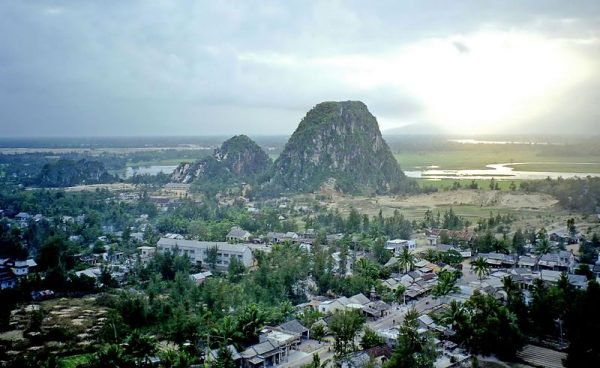
Morning on Marble Mountain
How to Get to the Marble Mountains:
The Marble Mountains are eight kilometers south of Da Nang city. From the city center, you cross Han River Bridge, follow Ngo Quyen street, Le Van Hien street, and finally turn onto Huyen Tran Cong Chua street.
Website: nguhanhson.org
Opening hours: 7:00 AM – 5:30 PM daily
Fees:
- Mount Water: 40,000 VND/ adult
- Hell Cave: 40,000 VND/ adult
- Elevator Fee (optional): 15,000 VND/ person/ time
- Guide Fee (optional): 50,000 VND/ group
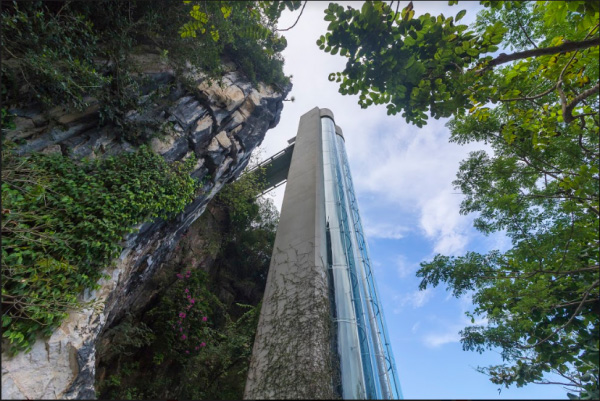
When to Visit:
Blessed by nature, the Marble Mountains are wonderful to visit at any time of the year. The most beautiful season to experience these tropical coastal mountains, though, is summer (June – August). But be aware that you must climb many stairs, so breathable clothing and water is a must. You may want to avoid the stormy season (usually from September – November) as the weather is more unpredictable and the stairs become dangerous when wet. I recommend making a day of visiting the Marble Mountains and then continue to Hoi An, to enjoy the beautiful beaches and fresh seafood for lunch. Wake up early and head to the Marble Mountains when there are few visitors and the air is still cool.
Some History & Where to Go:
The Marble Mountains were not named by the Vietnamese, but by the French after studying the chemical element of the mountain’s soil. In Vietnamese, it is known as Ngu Hanh Son (The Five Element Mountain). Accordingly, there are five separate mountains in the cluster, named after the five basic elements of life (according to Eastern philosophy): Kim Son (Mt. Metal), Moc Son (Mt. Plant), Thuy Son (Mt. Water), Hoa Son (Mt. Fire), and Tho Son (Mt. Soil).
Named by King Minh Mang, the five mountains were once a favorite destination for either the noble classes to visit or the anchorites, a Japanese school of Mahayana Buddhism emphasizing the value of meditation and institution, to set up sanctuaries. However, the history of this mountain cluster can be traced to hundreds of years before that, when the whole region still belonged to the Cham Kingdom. Today, stepping on each rustic stone stair, listening to your heart beat among the swinging rhythm of the forest, you could still feel the hundred-year-old statues whispering stories of the old days.
Time flies…
Kingdoms change…
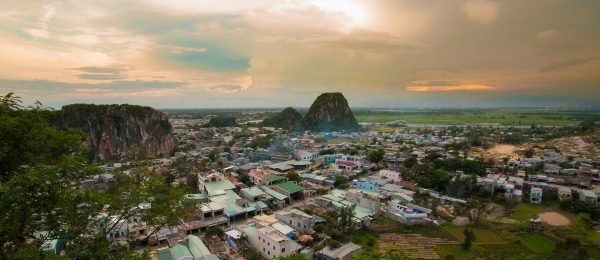
Located in a Marble Craft Village
The Marble Mountains are in the center of Non Nuoc Jewel village. This means you will pass through a 400-year old traditional craft village that specializes in marble before you actually reach the mountain. In the past, locals used the marble to create huge sculptures and naturaljewelryy. However, in recent years the government has tried to preserve the marble, so the artisans have started using natural stones from other areas to sustain their traditional business. If you want a natural souvenir to bring home, then you should really think about stopping in one of these locally owned stores. Otherwise, you can easily find jewellery sold near the gate of the Marble Mountains. Just note that I cannot guarantee the quality here.
If you visit this village and are lucky enough, a store owner may show you an interesting fact about the marble taken from the Marble Mountains. Try to notice the different color tones: pink from Mt. Water, white from Mt. Plant, red from Mt. Fire, light blue from Mt. Metal, and brown from Mt. Soil.
1. Soil
Before being conquered by the Tran Dynasty in 1471, this mountain was a good shelter for the Cham. Today, in one part of Mt. Soil, you can still find traces of the Cham Temples, the structure resembling that of My Son (a significant architectural structure of Hinduism, as Hindu had been the national religion of the Cham then), however less preserved. There are not many relics of historical construction on this side of the Marble Mountains. But hang on, the most attractive part is on your way – Mt. Water!
2. Water
Since being a part of Vietnam, the Marble Mountains, especially Mt. Water, has become a sacred place that attracts many Buddhist anchorites. If your time is limited, just pay the other mountains a short look on the internet, but never forget to drop by Mt. Water. Mother Nature and human beings over the past few centuries have been making this place an art of sanctuaries!
From the Sacred 400-year-old Pagoda…
Mt. Water is famous for its amazing system of pagodas and shrines either on the ground or inside the caves. Among many sacred pagodas there, Tam Thai Pagoda is a lively witness of the past that you surely do not want to miss. Head to the West of Mt. Water, walk 156 stone steps (built in 1630) set into the spine of the mountain, you will find yourself standing in front of an ancient three-entrance gate leading to a sunny yard.
It’s there that the 400-year-old pagoda makes its home! It was built in the 17th century, renovated many times, heavily destroyed during the doughty Tay Son Rebellion, significantly rebuilt in 1825 by King Minh Mang – the son of Tay Son’s enemy, destroyed again during the Vietnam War and the storm in 1991, then reconstructed… Today, we can still see the big copper plate molded under the King’s demand, inscribed with his gratitude toward Sakya Muni Buddha.
It seems as though this old pagoda wants to rest itself after those turbulent times, welcoming tourists from thousands of places around the world to its gentle sunny yard and humming a calming sound as if to echo peace to all its visitors.
To Amazing Natural Sanctuaries
It is not wrong to say that Mother Nature joined hands in making Mt. Water a Buddhist Sanctuary. If you look carefully at all the names of its caves cluster, you will notice that many of their names have Buddhist elements: Huyen Khong (Miracle Nothingness), Hoa Nghiem (Grave Rosin), Van Thong (Touching my Butt), etc. If you are on a tour, you will likely be taken to all of them.
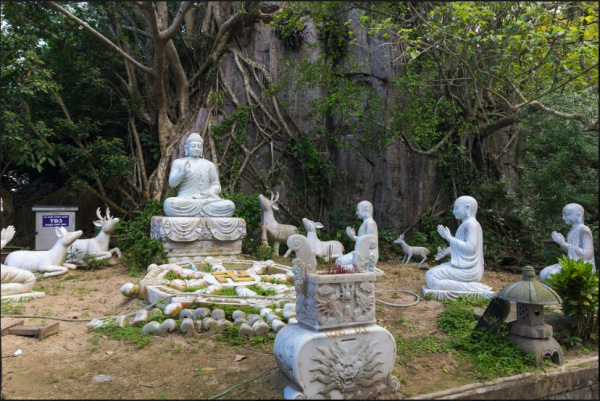
Be sure to stop and look at every sculpture garden.
Huyen Khong Cave – Heavenly Light!
Have you ever been enchanted with the way that light moves through natural landscapes, how light itself is meant to bend around things and reflect just to illuminate the beautiful? Let me assure you, such scenes of light and its ability to reveal beauty exist in Huyen Khong Cave, just as you descend the staircase into the mouth of the cavern. You will be amazed! Every fiber of sunlight slightly drops over the gravely gentle face of the huge Buddha statue sculpted naturally into the cliff opposite the gateway. The statue was made recently, in 1960.
If you walk further into the right part of the cavern (to the left of the Buddha statue), you will find the old Trang Nghiem Tu Temple, built in 1825, with three compartments. The main compartment is meant for worshipping Bodhisattva – who is believed to appear when you are in danger and you call for miracle help. The compartment on the left is for the worship of three Goddesses: Quan Cong, Quang Binh, and Chau Xuong, who respectively symbolize Morality, Wisdom, and Loyalty. The statue on the right is for worshipping the Goddess couple that brings good blessing to couples.
This sacred venue has undergone much change and been a witness to tumultuous history. More than once, the Marble Mountains have been used as an army station. During the French Colonial War, the cavern was a secret base for the local revolutionary authority. Afterward, since the Vietnam War, the American and the South Vietnam Government made this cavern a military exercise venue. In 1968, the Viet Minh took the control of the place, turning Huyen Khong cave into a surgery and medical area belonging to the liberation army. Place your hand on the stone of these caves, and you might understand why so many people have used it as a shelter of sorts.
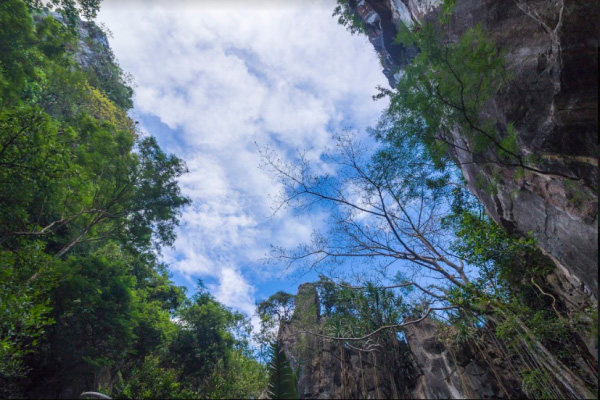
Hell Cave– Wondering What Hell Looks Like?
Opposite the depicted heavens of Huyen Khong Cave, Hell Cave is a tour of you guessed it, hell. But this isn’t an ordinary hell (if such a thing exists). Dark, humid, and at points fear-inducing, this cave is truly a good embodiment of what we believe hell to look like. With strange creatures hidden in the pockets of darkness and winding stairs that lead to spooky scenes, there is constant entertainment, and frightening faces in every corner.
Sir Good and Sir Bad guard the gate of hell, give them a long hard look and tell me what you think in the comments below. The Hell Cave is 302 meters long with great height, at some points the height reaches 40 to 50 meters. The natural cavern was cleverly crafted, sculptures were installed to deliver the core Buddhist belief: Karma – everything has its consequences. In this Hell Cave, the painful torture of bad people represents Karma, the extent of pain depends on the extent of their sins in past lives.
At the end of the cave, you will see the statue of Saint Arahat Mungkalaram talking to his mother, who has been suffering in hell for her sins (being greedy, trusting not in the law of cause and effect). In Buddhism, it is believed that the more moral and selfless a person, the wiser he is and the more power he has. If he continues to practice this way in the afterlife, he will attain Sainthood.
Saint Arahat and legendary Bodhisattvas are those with great morality and superpowers, who mostly use their power to save sentient beings from miseries. In this sculpture set, Saint Mungkalaram is teaching a lesson to his past life mother, interpreting the right and wrong of her past deeds. As long as the lady realizes her sins, feels guilty about them, and starts to think in a more ethical way, she will step by step get away from hell and transfer to a better life.
If you ask a Buddhist when hell ends, he shall reply: “When people live with ethics”.
3. Metal
If you are enjoying your time and want to see more, do not forget to drop by Mt. Metal. You can see Mt. Metal from the telescope on Mt. Water; Mt. Metal is like a huge bell leaning on Quan Am Pagoda. There, Quan Am Cavern is a must-visit spot! With the gateway facing the Southeast, hidden away from the cliffs, the cavern is particularly hard to find. It was not until 1956 that people discovered this amazing gem. The gateway is small, steep cliffs on both sides; as you get deeper inside, the cavern gets larger. It resembles the shape of the Cam Lo bottle that the Bodhisattva holds in her hand; the cave is 64 meters long, roughly seven meters high at its tallest part, and seven meters wide.
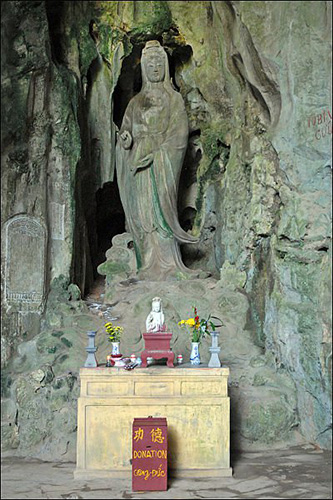
Quan Am cave is relatively closed off compared to other caves in the Marble Mountains, with huge rosin fairy figures. Most impressive is a natural marble sculpture of the Bodhisattva in human size, which is believed to be a magical result of the circuit waters’ abrasive process over the past centuries. And guess what? At the center of the cavern’s roof, there is a stalactite that drops to 0.3 meters above the floor, on which when you knock, you will hear a sound reassembling a bell. From the center, walk two meters further into the cave and you will find yourself in front of a beautiful pure water pond. The pond originated from one water circuit from Co Co River, crossing many rock layers, making its water flawlessly clear.
4 & 5. Mt. Plant & Mt. Fire
Contrary to the name, there are not many plants on Mt. Plant, and surely no fire on Mt. Fire! Mt. Plant was said to be, long ago, a beautiful mountain with majestic cliffs. After years of being heavily exploited, today the mountain looks like an old city wall that has long been abandoned.
Mt. Fire is a combination of two mountains (Positive Fire and Negative Fire) connected by a natural rock road. Mt. Positive Fire used to witness a jam-packed harbor on its side back to the time when people were trading between Hoi An and Da Nang on boats. On the river bank, today we can still find broken relics of the old Ong Chai Temple (Ong Chai means fisherman). If you visit this mountain, you should drop by two ancient pagodas: Linh Son Pagoda (with Huyen Vi Cave) and Pho Da Son Pagoda (with Pho Da Son cave). The slopes of the southwest side of the mountain are steep and craggy, pagodas and caves are therefore quiet compared to those on Mt. Water. Sporadic relics of Cham temples still exist in key parts of the mountain, reminding visitors how limited our creations are compared to that of Mother Nature.

Hundreds of years have passed since the Vietnamese adopted this region. Thousands of things have changed during wars and time that have passed. Maybe the space of a book would do this area justice, as there is so much history and spaces to explore. Therefore, I cannot fully convey the mystery, history, and beauty of this area in one article. Visit the Marble Mountains yourself, walk the steps and touch the stone walls of the ancient caves. You will understand more about this country that you travel, our people, and your inner peace, more than any words can attempt to describe.









